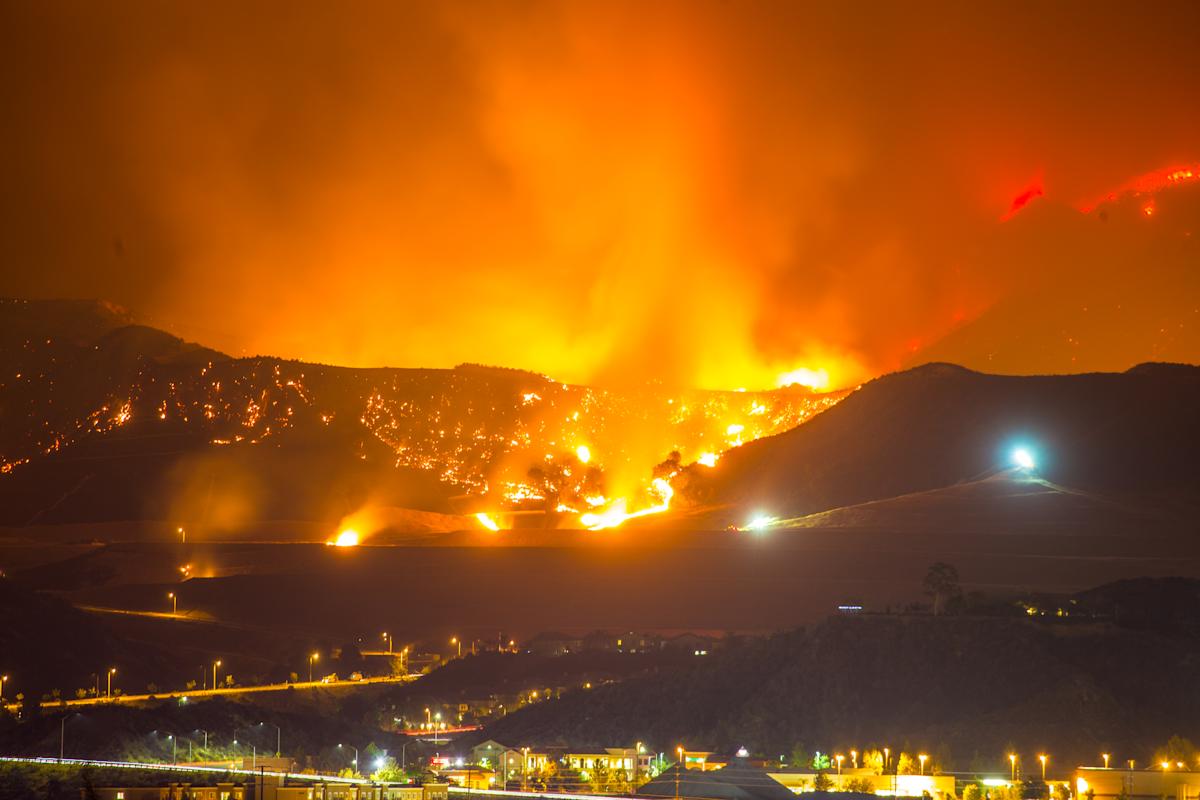Wildfires destroyed more than 2,400 homes in 2024 — not to mention threatening countless human lives. You may associate wildfires with states like California and Texas, but the U.S. Forest Service reports that about one-third of American homes are located in counties at high risk of wildfires.
While wildfire damage can be devastating, home insurance provides a safeguard against the worst financial impacts. But it’s important to understand what’s covered and be aware of any exclusions that could affect you.
This embedded content is not available in your region.
Homeowners insurance usually covers wildfires and related losses. Most policies include fire and smoke as covered perils, which are events your carrier agrees to insure you against.
A standard home insurance policy provides the following coverages that may apply to wildfire damage:
-
Dwelling coverage: This helps pay for repairing or rebuilding your home and other attached structures, like an attached garage or deck. Sometimes, this coverage includes detached structures, like a shed or separate garage. If a fire damages your roof or wall or destroys your home altogether, dwelling coverage would help pay for repairs or rebuilding.
-
Personal property coverage: This insures your personal belongings, like furniture, appliances, and clothing. This coverage could help you pay for replacing these items if they’re destroyed by a wildfire. Personal property coverage is included in most homeowners and rental insurance policies.
-
Loss of use coverage: Also called additional living expense (ALE) coverage, this helps pay for temporary living expenses, like hotels and extra food costs, if you’re displaced by a wildfire or another covered peril. Like personal property coverage, loss of use coverage is a feature of standard homeowner and renter policies.
Learn more: Homeowners insurance: What it covers and how much you’ll pay
Insurers are increasingly excluding wildfire damage in many high-risk areas. In these situations, you may be able to buy a standalone policy or add on an endorsement.
Many insurers are also canceling or refusing to renew policies for homes in places with frequent wildfires. Some carriers have stopped writing new policies in high-risk markets altogether.
You still have options for insuring your property if you can’t get coverage through a private insurer, but the premiums are often high and the coverage may be limited.
Learn more: What does home insurance not cover?
First, check your policy documents to verify that wildfires are covered by your home insurance. Most HO-3 policies (the most common type of home policy) include fire and smoke damage as covered perils.
Here are some tips to make sure you have the amount of home insurance you need when it comes to wildfires:
Tip 1: Consider insuring more than the standard RCV
Most home policies cover your home’s structure up to its replacement cost value (RCV), which is the cost of repairing or rebuilding it at today’s prices. But if many surrounding properties are damaged by a wildfire, the costs of building supplies and labor will likely increase, so standard RCV may not be enough.
Purchasing extended replacement cost coverage or guaranteed replacement cost coverage offers protection against these rising costs.
-
Extended replacement cost coverage can increase your dwelling coverage limit by up to 50%.
-
Guaranteed replacement cost coverage pays for the home’s full replacement cost even if it exceeds policy limits.
Your personal belongings are usually covered by your home policy, but the default is actual cash value (ACV), not replacement cost value (RCV) like your residence. Here’s the difference between ACV vs. RCV:
-
Actual cash value: ACV is the value of your property at the current market value. Since ACV accounts for depreciation, your reimbursement for destroyed personal belongings could be substantially less than the cost of actually replacing them.
-
Replacement cost value: RCV coverage, on the other hand, will replace your destroyed property with a brand-new item. Consider insuring your property at RCV instead of ACV for an additional cost if you’re worried your property won’t be covered enough.
Learn more: Actual cash value vs. replacement cost: Understanding the difference in home insurance
For example, let’s say your couch was damaged in a fire. You purchased it five years ago at $2,000, but now that same couch is only worth $700. With the default ACV on your homeowners insurance policy, you’d only get $700. But if you had added RCV coverage, you’d get a brand new couch of similar quality — worth the same $2,000 you spent five years ago.
Expert tip: If you own high-value items like artwork, jewelry, or collectibles, you may want to add a scheduled personal property endorsement for additional protection.
Many home and renters policies have a time limit of about 12 months of additional living expense (ALE) coverage, though some insurers have caps of up to 24 months. Choosing a policy with a longer time limit could make sense if you live somewhere at high risk of wildfires. This way, you won’t have to stress about covering your living expenses while you’re displaced and/or looking for a new home.
You can often save money on home insurance by choosing higher deductibles, but you’ll have to pay your full deductible before your policy kicks in. If you can’t afford to pay your deductible out of pocket, opting for lower deductibles — even if it means higher premiums — may be the safer choice. Keep in mind that, in some areas, separate deductibles may apply to wildfire claims.
Shopping for homeowners insurance covering wildfire damage can be tough if you live somewhere vulnerable to widespread blazes. Here are some options for wildfire insurance in high-risk areas.
Fair Access to Insurance Requirements (FAIR) plans are state-run pools that serve as insurers of last resort for property owners in high-risk areas. These plans cover wildfire damage and are available in all 50 states. However, you may need to make upgrades to fireproof your home to qualify.
FAIR plans are designed to be temporary and usually offer lower limits at a higher cost. While dwelling coverage is usually included, you may need to buy separate insurance for your personal property and ALE coverage.
Surplus or excess line (E&S) carriers are specialty insurers that cover high-risk scenarios that traditional insurers avoid. Traditional insurers are “admitted” carriers, meaning they’re licensed and regulated by the states in which they operate.
E&S insurance carriers aren’t bound by state laws and regulations. While they have more flexible underwriting standards, they also come with fewer protections than admitted carriers. For example, admitted carriers are backed by a state’s guarantee fund, which pays out claims if an insurer becomes insolvent, whereas E&S insurers have no such backing.
E&S insurance may be necessary if:
-
You live in an area at high risk of wildfires or other natural disasters.
-
You need high coverage limits.
-
You don’t meet a standard carrier’s underwriting guidelines for some other reason, like you have an older home or you’ve filed multiple claims in a short window.
Some premier carriers specialize in high-value homes, typically those worth over $1 million. These insurers often provide extensive coverage and mitigation services like private firefighting.
Yes, insurance companies can refuse to renew your policy due to wildfires or exclude wildfire damage from coverage. Some companies opt to pull out of high-risk areas altogether.
Insurers canceling or declining to renew policies in high-risk areas is becoming more common, especially as wildfires become a year-round phenomenon instead of a mostly seasonal occurrence. A December 2024 Senate Budget Committee report found high rates of nonrenewals in places that are especially vulnerable to wildfires, like California, eastern New Mexico, and Colorado.
Your safety comes first, so avoid returning home after a wildfire until you get the green light from local officials. Once you return, take any necessary steps to secure your property to avoid further losses, like boarding up broken windows or placing a tarp over a damaged roof. Then, follow these steps to file a wildfire insurance claim:
-
Contact your carrier or insurance agent ASAP. Once you’ve determined that the cost of your property damage likely exceeds your deductibles, notify your insurance company or agent as soon as possible. Ideally, you can do this by phone, though many insurers set up temporary on-site claim centers after major disasters when cell service is often limited. Make sure you get a claims number. Make note of any deadlines or other requirements for filing a claim.
-
Take a thorough inventory of the damage. You’ll need to document any damage to your home and personal property for your insurance adjuster. Gather any evidence you have, like receipts and photos, to help you document the damage. You may also want to get bids from contractors to estimate repair or replacement costs before the adjuster inspects your home.
-
Document every conversation. Take notes during every conversation with your insurance company. Ask for the name and phone number of each person you speak with.
-
Meet with the insurance adjuster onsite. At some point, a company insurance adjuster will inspect your home. The National Association of Insurance Commissioners (NAIC) notes that an inspection can happen in as little as three to five days for minor claims, but after a major disaster, the process can take significantly longer.
-
Consider a public adjuster. If you disagree with the adjuster’s assessment or if your case is especially large or complex, hiring a public adjuster who can advocate for you may be worthwhile.
Wildfires can spread rapidly and cause devastating damage, but here are some ways to mitigate the risk, according to FEMA:
-
Create a 30-foot buffer with minimal vegetation around your home.
-
Store combustible materials, like firewood and gas grills, away from the home.
-
Enclose porches, balconies, and overhangs with exposed space underneath.
-
Cover vents with corrosion-resistant wire mesh.
-
Opt for fire-resistant roofing materials, like single-ply membranes or fiberglass shingles, instead of flammable materials, like wood or shingle.
-
Cover chimneys and stovepipes with spark arrestors.
Renters insurance usually offers personal property coverage for wildfire damage, and it often includes ALE coverage if you’re temporarily displaced. However, renters insurance doesn’t provide dwelling coverage. Your landlord’s insurance would kick in if the physical home or building is damaged in a wildfire.
Learn more: How an auto and renters insurance bundle can save you big
Wildfire damage to vehicles is usually covered if you have comprehensive insurance. This type of coverage protects against car damage not caused by collisions, like losses from severe weather or falling objects.
You’re usually required to maintain comprehensive car insurance coverage if you finance or lease a vehicle; however, it’s not legally required in any state. So if you only carry your state’s minimum coverage levels, your vehicle likely won’t be insured against wildfire damage.
Learn more: Bundle home and auto insurance: Be sure it’s the best deal
Hiring a public adjuster for a wildfire claim may be helpful if you feel your insurer is shortchanging your claim or need help navigating your policy or the claims process. For example, if you’re struggling to provide evidence of your losses or don’t understand the legal jargon in the insurance contract, you might benefit from hiring a public adjuster.
Jamie Young and Tim Manni edited this article.







